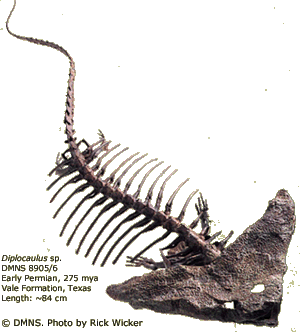 |
 |
 |
 |
 |
Produced
by the Population Genetics and Evolution class, Furman University |
||||
 |
 |
 |
 |
 |
Produced
by the Population Genetics and Evolution class, Furman University |
||||
 |
The
Carboniferous: Lepospondyls |
 |
||
| Lepospondyls
were a group of small Carboniferous Labyrinthodonts (Blade 2010). They
are a very diverse group consisting of species that were aquatic, semi-aquatic
and terrestrial (Blade 2010). Six different clades of Lepospondyli are
known, including: Acherontiscidae, Adelospondyli, Aistopoda, Lysorophia,
Microsauria and Nectridea. Within these clades we find newt-like, eel-
or snake like, and lizard-like forms, and some deserving of their own
category (Blade 2010, White 2009). None of these animals were large, usually
no longer than a few centimeters (Blade 2010). The largest members, in
the genus Diplocaulus, reached a meter in length (Blade 2010,
Bakker 2007). These small Labyrinthodonts lived in highly specialized
niches in areas where competitors were rare (Blade 2010). Lepospondyls
are characterized by a “simple, spool-shaped vertebra, which were
not performed as cartilage, but rather grew as bony cylinders around the
notochord” (Blade 2010). Uniquely, the neural arch is fused to the
centra portion of the vertebra (Blade 2010). The common ancestors of this
group is unknown because each clade in so highly specialized (Blade 2010)
Lepspondyls may be ancestral to one group of extant amphibians - the caecilians.
Page by Matt Medlin |
 |
| The Lepospondyl, Diplocaulus. Photo from: www.david-angel.net | |
|
Blade L. 2010. Lepospondyli. Wikipedia.com. Accessed March 3, 2010. Bakker R. 2007. Diplocaulus. Accessed March 3, 2010. White AT. 2006. Lepospondyli. www.palaeos.com Accessed March 3, 2010. |